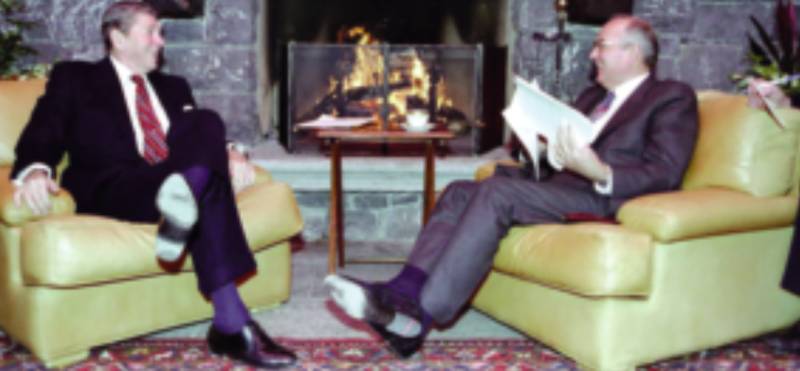
This photograph shows President Ronald Reagan and Soviet General Secretary Mikhail Gorbachev at the First Summit in Geneva, Switzerland in 1985.
This Cold War-era meeting was held on November 19 and 20, 1985, between U.S. President Ronald Reagan and Soviet General Secretary Mikhail Gorbachev. The two leaders met for the first time to hold talks on international diplomatic relations and the arms race.
Both the Soviet Union and the United States were seeking to cut the number of nuclear weapons, with the Soviets seeking to halve the number of nuclear-equipped bombers and missiles, and the U.S. desiring to ensure that neither side gained a first-strike advantage, and to protect rights to have defensive systems. Diplomats struggled to come up with planned results in advance, with Soviets rejecting the vast majority of the items that U.S. negotiators proposed. With the meeting planned months in advance, the two superpowers used the opportunity to posture and to stake their positions in the court of public opinion.
The meeting itself was held at Maison de Saussure, a chateau rented by His Highness the Aga Khan. Gorbachev later said: “We viewed the Geneva meeting realistically, without grand expectations, yet we hoped to lay the foundations for a serious dialogue in the future.” Reagan described his hopes for the summit as a “mission for peace.” The first thing Reagan said to Gorbachev was “The United States and the Soviet Union are the two greatest countries on Earth, the superpowers. They are the only ones who can start World War 3, but also the only two countries that could bring peace to the world.” He then emphasized the personal similarities between the two leaders, with both being born in similar “rural hamlets in the middle of their respective countries” and the great responsibilities they held.
Their first meeting exceeded their time limit by over a half an hour. The first day, Mikhail Gorbachev argued that the United States did not trust them and that its ruling class was trying to keep the people uneasy. Ronald Reagan countered that the Soviets had been acting aggressively and suggested the Soviets were overly paranoid about the United States. They broke for lunch and Reagan promised Gorbachev he’d have a chance to rebut. They talked outside for about two hours on the Strategic Defense Initiative, but both stood firm. Gorbachev accepted Reagan’s invitation to the United States in a year, and Reagan was invited to do the same in 1987. On the second day, Reagan went after human rights, saying that he did not want to tell Gorbachev how to run his country, but that he should ease up on emigration restrictions. Gorbachev claimed that the Soviets were comparable to the United States and quoted some feminists. The next session started with arguments about the arms race, then went into SDI. They agreed to a joint statement.

This Cold War-era meeting was held on November 19 and 20, 1985, between U.S. President Ronald Reagan and Soviet General Secretary Mikhail Gorbachev. The two leaders met for the first time to hold talks on international diplomatic relations and the arms race.
Both the Soviet Union and the United States were seeking to cut the number of nuclear weapons, with the Soviets seeking to halve the number of nuclear-equipped bombers and missiles, and the U.S. desiring to ensure that neither side gained a first-strike advantage, and to protect rights to have defensive systems. Diplomats struggled to come up with planned results in advance, with Soviets rejecting the vast majority of the items that U.S. negotiators proposed. With the meeting planned months in advance, the two superpowers used the opportunity to posture and to stake their positions in the court of public opinion.
The meeting itself was held at Maison de Saussure, a chateau rented by His Highness the Aga Khan. Gorbachev later said: “We viewed the Geneva meeting realistically, without grand expectations, yet we hoped to lay the foundations for a serious dialogue in the future.” Reagan described his hopes for the summit as a “mission for peace.” The first thing Reagan said to Gorbachev was “The United States and the Soviet Union are the two greatest countries on Earth, the superpowers. They are the only ones who can start World War 3, but also the only two countries that could bring peace to the world.” He then emphasized the personal similarities between the two leaders, with both being born in similar “rural hamlets in the middle of their respective countries” and the great responsibilities they held.
Their first meeting exceeded their time limit by over a half an hour. The first day, Mikhail Gorbachev argued that the United States did not trust them and that its ruling class was trying to keep the people uneasy. Ronald Reagan countered that the Soviets had been acting aggressively and suggested the Soviets were overly paranoid about the United States. They broke for lunch and Reagan promised Gorbachev he’d have a chance to rebut. They talked outside for about two hours on the Strategic Defense Initiative, but both stood firm. Gorbachev accepted Reagan’s invitation to the United States in a year, and Reagan was invited to do the same in 1987. On the second day, Reagan went after human rights, saying that he did not want to tell Gorbachev how to run his country, but that he should ease up on emigration restrictions. Gorbachev claimed that the Soviets were comparable to the United States and quoted some feminists. The next session started with arguments about the arms race, then went into SDI. They agreed to a joint statement.


